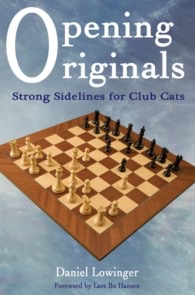Opening Originals: Strong Sidelines for Club Cats
Daniel Lowinger

These days most of the prominent publishers producing chess books are based in Europe (Quality Chess, Everyman Chess, Gambit and New in Chess) but there are some excellent American firms including McFarland, Mongoose and Russell Enterprises Inc. (www.russell-enterprises.com). The latter has been in business since 1986 and has published close to 100 books. Its latest two are written by American masters with extensive teaching and writing experience.
The first, Reaching the Top ?!: A Practical Guide to Playing Master-Level Chess by Peter Kurzdorfer, with a foreword by Cyrus Lakdawala, is aimed at the dedicated amateur who loves the game and aspires to become a master. Kurzdorfer uses his own games as the raw material for this book which is arranged around eight chapters:
Chapter 1
Learning From Past Mistakes
Chapter 2
Choose Openings to Suit Your Style
Chapter 3
Handling Material Inequality
Chapter 4
Practical Endgames
Chapter 5
How Sound Do Your Openings Need to Be?
Chapter 6
When Things Go Terribly Wrong 194
Chapter 7
Overcoming Difficulties 223
Chapter 8
How to Win 258
Unlike many improvement books which are written by Grandmasters and International Masters who earned their master title within a few years of taking up the game, Kurzdorfer had to work hard to get to 2200 and has a very objective view of what a national master is. One thing they are not, as he humbly mentions in his introduction, are players who have mastered the game. This reviewer would agree with that assertion, and reserve that distinction to Grandmasters rated over 2600, and yet attaining the NM title is an honor that only one percent of USCF members attain.
The author is quite realistic in what is required to reach 2200. Not willing to work hard or study your losses carefully? Then you almost certainly will not make it. Dont live in a major metropolitan area with plenty of chess activity and not willing to travel. Again you are not going to reach 2200 because you simply wont get enough experience and rated games.
Kurzdorfer has lived in many places these last few decades, some with a lot of strong players and others (like Buffalo and San Diego in the early 1980s) with not so many, resulting in him playing the same opponents on many occasions. He has useful advice to offer for how to deal with this situation, something amateur players outside major chess centers run into frequently.
Recommended for players from 1600 to 2200.
Daniel Lowingers Opening Originals: Strong Sidelines for Club Cats is a rare opening book. Its not encyclopedic, not an opening repertoire book and is definitely not aimed at professional players (though they might pick up some interesting ideas). Instead it is aimed at amateur players with limited study time who are looking for inspiration whether it be fixing a hole in their repertoire or finding a surprise to spring on an opponent they often face. The closest opening series that compares is Secrets of Opening Surprises by New in Chess. There are similarities (both arranged around model games), but also differences – more emphasis on opening analysis in Secrets and more analysis of the entire game by Lowinger who offers more explanatory prose and aims at the lower rated player.
The openings the author covers are as follows:
Part I: Mrs. Majestys Magnificence
Chapter 1: Anti-Alapin 1.e4 c5 2.c3 Qa5!?
Chapter 2: Dutch Destroyer 1.d4 f5 2.Qd3!?
Chapter 3: Cutting-edge Caro 1.e4 c6 2.d4 d5 3.e5 Bf5 4.h4 h5 5.Bg5 Qb6 6.Bd3 Qxd4!?
Chapter 4: Confounding Kan 1.e4 c5 2.Nf3 e6 3.d4 cd 4.Nd4 a6 5.c4 Nf6 6.Nc3 Bb4 7.Qf3!?
Part II: Petite Path to Parity Chapter 5: Forcing French 1.e4 e6 2.d4 d5 3.Nc3 Nf6 4.Bg5 Be7 5.e5 Nfd7 6.Bxe7 Qxe7 7.Nb5!?
Chapter 6: Senegalese Surprise 1.e4 e6 2.d4 d5 3.Nd2 Nf6 4.e5 Nfd7 5.Bd3 c5 6.c3 b5!?
Chapter 7: Breyer Bruiser 1.e4 e5 2.Nf3 Nc6 3.Bb5 a6 4.Ba4 Nf6 5.00 Be7 6.Re1 b5 7.Bb3 d6 8.c3 00 9.h3 Nb8 10.d4 Nbd7 11.Nh4!?
Chapter 8: Attack the Accelerated 1.e4 c5 2.Nf3 Nc6 3.d4 cxd4 4.Nxd4 g6 5.Nc3 Bg7 6.Be3 Nf6 7.Nxc6!? bxc6 8.e5
Part III: Robust Repertoire Repeatables
Chapter 9: Quiet KID 1.d4 Nf6 2.c4 g6 3.Nc3 Bg7 4.e4 d6 5.Nf3 0-0 6.Be2 e5 7.0-0 Nbd7!?
Chapter 10: Serene Scandinavian 1.e4 d5 2.ed Qxd5 3.Nf3!?
Chapter 11: Caro Cruncher 1.e4 c6 2.d4 d5 3.e5 c5 4.dxc5 e6 5.a3!?
Chapter 12: Polish Punch 1.e4 e6 2.d4 d5 3.Nd2 Nf6 4.e5 Nfd7 5.Bd3 c5 6.c3 Nc6 7.Ne2 a5!?
Chapter 13: Slow the Semi-Tarrasch 1.d4 Nf6 2.c4 e6 3.Nc3 d5 4.cxd5 Nxd5 5.e4 Nxc3 6.bxc3 c5 7.a3
Chapter 14: Killing Quiet Play 1.c4 Nf6 2.g3 g6 3.Bg2 Bg7 4.Nc3 0-0 5.e4 c5 6.Nge2 Nc6 7.d3 d6 8.0-0 a6 9.h3 Rb8 10.a4 Ne8 11.Be3 Bd7 12.d4 b6!? Chapter 15: Donners Doozy 1.c4 Nf6 2.Nf3 g6 3.g3 Bg7 4.Bg2 0-0 5.0-0 d6 6.Nc3 a6!?
Recommended for players from 1800 to 2200.
